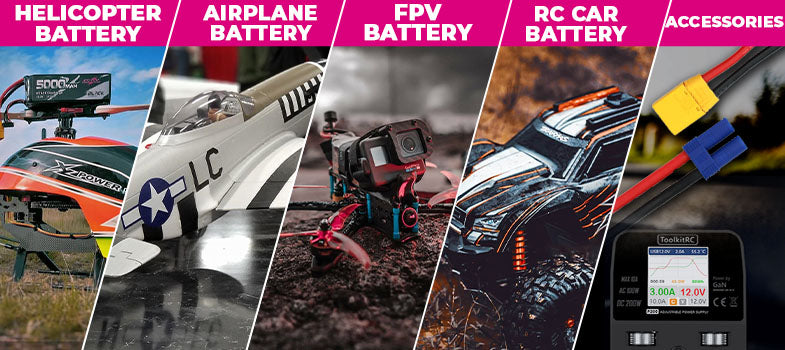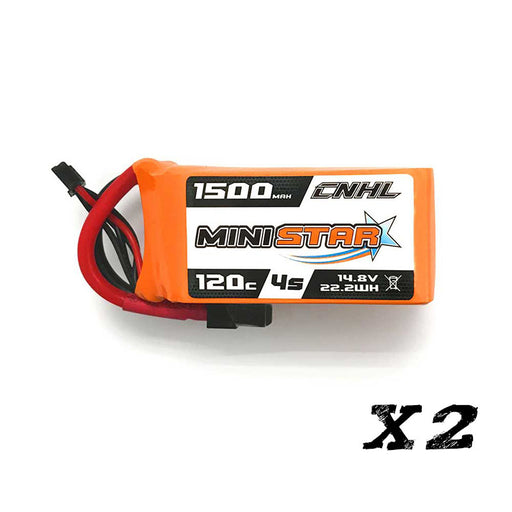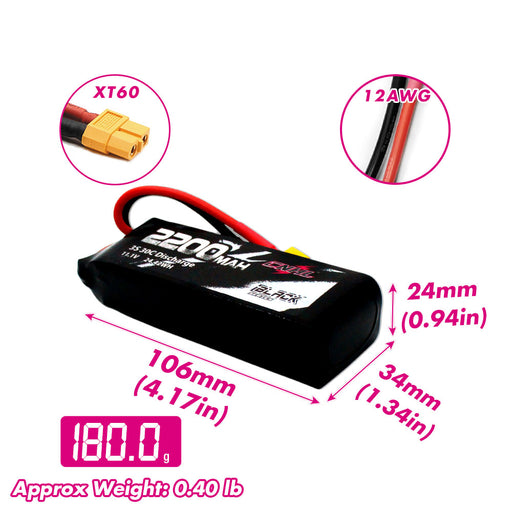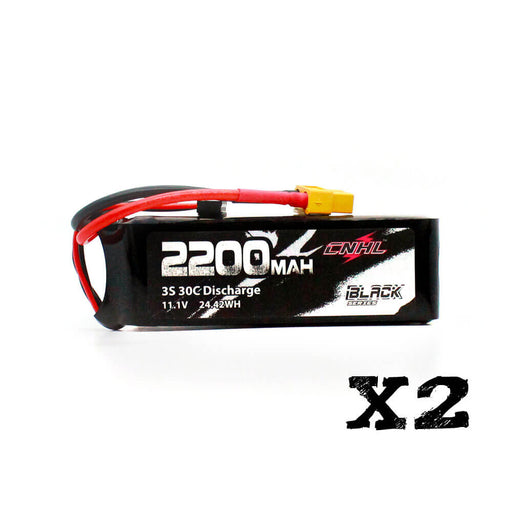
最も見落とされがちなリポ充電器の仕様:バランス電流
リポ充電器についてすべて知っていると思っているなら、挑戦があります。リポ充電器の仕様の中でよく見落とされがちなものが一つあり、それはかなり重要です。大きくて強力な充電器と強力な電源があっても、そのパラメータが原因で充電サイクルが非常に長くなることがあります。そのパラメータはバランス充電電流です。このブログでは、充電器を選ぶ際にバランス充電電流を絶対に見落としてはいけない理由について話します。
充電器を購入するとき、最も重要な質問は「バッテリーの充電にどれくらい時間がかかるか」だと思います。十分な時間があれば、小さくて弱い充電器でも非常に大きなバッテリーを充電できますが、何時間も待ち続けたい人はいません。パックの充電を待ちますか?飛行したいですよね。
おそらくワット数の定格などのパラメータを見ることに慣れているでしょう。ここではISDT k2を見ていますが、これは2チャンネルで500ワットの定格、または200ワットの定格、あるいは20アンペアの定格を持っています。

もしこれらのことを分析して、バッテリーの充電にどれくらい時間がかかるかを完全に理解していないなら、それで十分ですか?200ワットで十分ですか?500ワットで十分ですか?しかし、今日話すことは誰もあまり考えないことです。いや、誰もと言いましたが、もしこれをすでに知っている人なら、おめでとうございます!でも多くの人は見落としています。
では、充電の仕組みとバランス機能が何をするのかを簡単に見ていきましょう。これにより、なぜバランス充電率が充電器の性能にとって大きな制限となるのか理解できます。ここではバッテリーの表現を見ています。4セルバッテリーを使っていますが、これはこのブログにあまり多くのグラフィックを入れたくなかったからです。5セルでも6セルでも同じように動作します。
これはバッテリーの充電状態を表しています。これらのバッテリーはやや放電されており、この黄色い部分はどれだけ充電されているかを示しています。約3ボルト近くまで下がっており、4.2ボルトまたは満充電の状態ではありません。理想的な条件下では、バッテリーを放電した後、すべてのセルはまったく同じ量だけ放電し、まったく同じ電圧に達します。理想的な条件では、すべてのセルの内部抵抗は同じであるため、電流を吸い取るときも均等に吸い取られます。現実には必ずしもそうではありませんが、ここではそう考えましょう。これらのセルを充電するとき、充電の仕組みは充電器がメインの放電リードを通じてバッテリーに電流を押し込み、すべてのセルを一緒に充電するというものです。

すべてのセルは同じ速度で充電され、すべてが同時に4.2ボルトの満充電に達し、すべてが完璧に動作するはずです。しかし、現実の世界ではそうはなりません。現実では、すべてのセルの内部抵抗は完全に一致しないため、すべてのセルが4.2ボルトの満充電状態から始まっても、通常の使用中に一部のセルは他のセルよりも低い電圧まで放電します。ここにその様子が表されています。このセルは少し高く、このセルは少し低く、すべて異なる充電状態にあります。

では、メインの放電リードを通じてこれらのセルを充電するとします。これは充電が常に行われる方法です。すると何が起こるでしょうか?リポ充電電流がメインの放電リードを通じてセルに流れると、すべてのセルは内部抵抗の差に比例して同時に充電され始めます。つまり、セルが満たされ始めるのです。ここで問題が見えます。これはバランス充電が解決するために設計された問題です。すべてのセルはほぼ同じ速度で充電されますが、最も電圧が高かったセルが最初に4.2ボルトに達します。この時点で充電を続けると、充電はすべてのセルに流れ続けるため、そのセルは4.2ボルトを超えてしまい、4.2ボルトを超える充電は一般的に安全ではないため危険な状態になります。しかし他のセルは4.2ボルトに達していません。ではどうするか?充電器はメインリードを通じてすべてのセルを充電し続けますが、満充電のセルが過充電にならないように、4.2ボルトを超えてあふれそうになる満充電セルから電流を吸い取るようになります。まるでソーダがあふれそうな時に吸い込むように、それがバランスリードで起こっていることです。つまり、電流はメインの放電リードから入り、すべてのセルを同時に満たし、1つのセルの電圧が高くなりすぎると、充電器は満充電セルから電流を引き抜き続けるのです。
これで残りのセルが満充電に近づくのがわかります。満充電になると、充電器はそれらのセルから電流を引き出し、4.2ボルトを超えて過充電になるのを防ぎます。そして最後のセルが4.2ボルトに達すると、充電プロセスは完了します。

ほとんどの人がバランス充電の仕組みをそうは考えていません。多くの人は、充電器がバランスリードを通じて電流を押し込み、各セルを一度に一つずつ4.2ボルトに達するまで充電していると思っています。各セルが4.2ボルトに達すると完了です。そのように動作する充電器もいくつかありますが、通常はそうではありません。なぜそうならないのかは正直わかりません。おそらく、小さな充電器を4つ作るのは複雑で、大きな充電器1つと過充電を防ぐバランスルーチンを作る方が簡単だからかもしれません。なぜこの方法を採用しているのかはよくわかりませんが、これが実際のやり方です。問題は、セルの放電が非常に遅く非効率的であることです。少なくとも充電器の作り方としてはそうです。これらの充電器が放電する方法は、抵抗器のバンクに電流を流すだけで、基本的にその電荷を熱に変換しています。例えば、大きなオンクと巻線抵抗器を例にとりましょう。この機器のワット数は覚えていませんが、数十ワットか数百ワットかもしれません。この巨大なものを通して大量の電流を放電できます。ファンをつけて風を当てれば、4sリポバッテリーから7810アンペアを放電しても過熱や損傷はしません。この装置は非常に大きいですが、あなたの充電器にはそんなものは入っていません。充電器には小さな抵抗器のバンクがあり、それらの抵抗器は熱くなり、小さなファンがそれらに風を送ります。充電器が自分自身を焼き切らないようにするために、放電電流は速くできず、だからこそ充電器をストレージモードにすると、充電中はバッテリーが多くの電流を受け入れられるため非常に速く進みます。しかし放電時は通常最大約2アンペアまでしか放電できず、バランス調整は放電を伴います。
充電器を購入するときは、ワット数やアンペア数だけでなく、仕様のどこかにあるバランス電流も確認してください。バランス電流は、個々のセルが4.2ボルトに達したときにバッテリーをどれだけ速く充電できるかを制限します。例えば、5000ミリアンペア時の6セルパックで、あるセルが4.2ボルトに達して満充電になり、バランス電流が500ミリアンペア(あまり良くない仕様)だった場合、充電プロセス全体が500ミリアンペアに遅くなります。これは、充電器が満充電セルから上澄みの電流を500ミリアンペアでしか取り出せないためです。つまり、500ワット20アンペアの充電器で大きなバッテリーに500ワットを投入していても、セルの一つが4.2ボルトに達すると500ミリアンペアしか流せず、充電全体が遅くなるということです。
充電サイクルの最後で充電が非常に遅くなる理由を疑問に思ったことがあるなら、これがその一因かもしれません。他にも理由はありますがここでは触れません。ただし、充電器のバランス電流が非常に低く、バッテリーのバランスが大きく崩れている場合、またはバッテリーが大きくて少しバランスが崩れている場合、充電サイクルの最後の数パーセントが非常に遅くなる原因となります。
別の充電器、Hota D6を見てみましょう。私が持っているのはD6デュオで、これはD6 Proです。バランス電流は1600ミリアンペアでかなり良いです。バランス電流が約1〜1.5アンペア以上あればかなり良好で、1アンペア未満だとあまり良くありません。もちろん多い方が良いですが、すべてのバランスを取る必要があります。充電器を選ぶ際に考慮すべき他のすべての要素もありますが、多くの充電器はメインの製品ページにバランス電流を記載していないことに注意してください。マニュアルをダウンロードするか、自分で調べる必要があります。注意が必要です。名前は出ませんが、ワット数の仕様は非常に印象的でも、バランス電流が非常に悪く、パックの充電に非常に時間がかかる充電器が存在します。そういったものは避けた方が良いかもしれません。

こちらでフルビデオをご覧ください:

ベストセラー
-
元の価格 $65.99元の価格 $65.99 - 元の価格 $65.99元の価格 $65.99$53.99 USD - $65.99 USD$53.99 - $65.99現在の価格 $53.99 USD
CNHL G+Plus 5000mAh 22.2V 6S リポバッテリー 70C EC5プラグ付き
在庫に10以上あります仕様: ストック番号: 500706EC5 容量: 5000mAh 電圧: 22.2V / 6セル / 6S1P 放電率: 70C 継続 / 140C バースト 充電率: 最大5C サイズ(1-5mmの誤差): 49X51X149mm(高さ*幅*長さ) おおよその重量(±5g) : 71...
詳細をすべて表示元の価格 $65.99元の価格 $65.99 - 元の価格 $65.99元の価格 $65.99$53.99 USD - $65.99 USD$53.99 - $65.99現在の価格 $53.99 USD最大18%節約 -
元の価格 $38.99元の価格 $38.99 - 元の価格 $38.99元の価格 $38.99$34.99 USD - $38.99 USD$34.99 - $38.99現在の価格 $34.99 USD
CNHL スピーディーピザシリーズ プロ 1350mAh 22.2V 6S 150C リポバッテリー XT60プラグ付き
残り10台のみ仕様: 在庫番号: 1351506PZ 容量:1350mAh 電圧:22.2V / 6セル / 6S1P 放電率:連続150C / バースト300C 充電率:最大5C サイズ(1-5mmの差異あり):38X38X78mm おおよその重量(±5g):215g 出力コネクター:XT60 バラン...
詳細をすべて表示元の価格 $38.99元の価格 $38.99 - 元の価格 $38.99元の価格 $38.99$34.99 USD - $38.99 USD$34.99 - $38.99現在の価格 $34.99 USD最大10%節約 -
元の価格 $51.98元の価格 $51.98 - 元の価格 $51.98元の価格 $51.98$46.78 USD - $51.98 USD$46.78 - $51.98現在の価格 $46.78 USD
2パック CNHL ブラックシリーズ V2.0 1300mAh 22.2V 6S 130C リポバッテリー XT60プラグ付き
在庫に10以上あります仕様 在庫番号: 1301306BK 容量: 1300mAh 電圧: 22.2V / 6セル / 6S1P 放電率: 130C 継続 / 260C バースト 充電率: 最大5C サイズ(1-5mmの差異あり): 48X33X77mm 重量(±5g): 210g 出力コネクター: XT60 バ...
詳細をすべて表示元の価格 $51.98元の価格 $51.98 - 元の価格 $51.98元の価格 $51.98$46.78 USD - $51.98 USD$46.78 - $51.98現在の価格 $46.78 USD最大10%節約 -
元の価格 $43.98元の価格 $43.98 - 元の価格 $43.98元の価格 $43.98$31.98 USD - $43.98 USD$31.98 - $43.98現在の価格 $31.98 USD
[Combo] 2パック CNHL MiniStar 1500mAh 14.8V 4S リポバッテリー 120C XT60プラグ付き
在庫に10以上あります仕様: 在庫番号:1501204 容量:1500mAh 電圧:14.8V / 4セル / 4S1P 放電率:連続120C / バースト240C 充電率:最大5C サイズ(1-5mmの差異):37X33X76mm おおよその重量(±5g):169g 出力コネクター:XT60 バランスコネクター...
詳細をすべて表示元の価格 $43.98元の価格 $43.98 - 元の価格 $43.98元の価格 $43.98$31.98 USD - $43.98 USD$31.98 - $43.98現在の価格 $31.98 USD最大27%節約 -
元の価格 $23.98 - 元の価格 $37.98元の価格 $23.98 - 元の価格 $37.98元の価格 $23.98$19.98 USD - $37.98 USD$19.98 - $37.98現在の価格 $19.98 USD
2パック CNHL ブラックシリーズ 2200mAh 3S 11.1V 30C リポバッテリー XT60プラグ付き
在庫に10以上あります仕様: 在庫番号:220303BK 容量:2200mAh 電圧:11.1V / 3セル / 3S1P 放電率:30C連続 / 60Cバースト 充電率:最大5C サイズ(1-5mmの誤差あり):24X34X106mm おおよその重量(±5g):180g 出力コネクター:XT60 バランスコネク...
詳細をすべて表示元の価格 $23.98 - 元の価格 $37.98元の価格 $23.98 - 元の価格 $37.98元の価格 $23.98$19.98 USD - $37.98 USD$19.98 - $37.98現在の価格 $19.98 USD最大17%節約
新しいアイテム
-
元の価格 $120.00 - 元の価格 $120.00元の価格 $120.00$120.00 USD$120.00 - $120.00現在の価格 $120.00 USD
MNRC MN300 RTR 1/12スケール 4WD RC ロッククローラー オフロードトラック 2速トランスミッション付き
残り9台のみMNRC MN300は1/12スケールのレディトゥラン(RTR)4WD RCロッククローラーで、軽いクローリング、トレイル走行、日常のオフロードの楽しみのために作られています。電子機器が組み込まれた状態で組み立て済みで、7.4VバッテリーとUSB充電ケーブルが箱に同梱されています。「全か無...
詳細をすべて表示元の価格 $120.00 - 元の価格 $120.00元の価格 $120.00$120.00 USD$120.00 - $120.00現在の価格 $120.00 USD -
元の価格 $119.99 - 元の価格 $119.99元の価格 $119.99$119.99 USD$119.99 - $119.99現在の価格 $119.99 USD
VOLANTEX スピットファイア RC 飛行機 4チャンネル 6軸ジャイロ安定化機能付き すぐに飛ばせる
残り9台のみ第二次世界大戦の伝説的な英国戦闘機に触発されたVOLANTEX スピットファイア RCプレーンは、クラシックな戦闘機の外観と初心者に優しい最新の飛行制御を融合しています。VOLANTEXの実績ある400mmプラットフォームを基に構築され、このすぐに飛ばせるRC飛行機はXPILOT安定化...
詳細をすべて表示元の価格 $119.99 - 元の価格 $119.99元の価格 $119.99$119.99 USD$119.99 - $119.99現在の価格 $119.99 USD -
元の価格 $122.99 - 元の価格 $122.99元の価格 $122.99$122.99 USD$122.99 - $122.99現在の価格 $122.99 USD
VOLANTEX BF109 RC 飛行機 4チャンネル RTF – ジャイロ&XPilot搭載 第二次世界大戦戦闘機
残り9台のみVOLANTEX BF109 4チャンネル RCプレーン RTFは、最も象徴的な第二次世界大戦の戦闘機の一つを、コンパクトで初心者に優しいパッケージにまとめました。400mmの翼幅、軽量なEPPフォーム製の機体、そしてXPilotジャイロシステムを備えたこの戦闘機は、新しいパイロットに滑...
詳細をすべて表示元の価格 $122.99 - 元の価格 $122.99元の価格 $122.99$122.99 USD$122.99 - $122.99現在の価格 $122.99 USD -
元の価格 $117.99 - 元の価格 $117.99元の価格 $117.99$117.99 USD$117.99 - $117.99現在の価格 $117.99 USD
Volantex RC プレーン P51D V2 400mm RTF – 初心者向けXPilotスタビライザー付き4CHウォーバード
残り9台のみVolantex RC Plane P51D V2 RTFは、学習をできるだけリラックスして行えるように設計されたコンパクトな第二次世界大戦スタイルの戦闘機です。400mmの翼幅、EPPフォーム構造、XPilot 6軸スタビライザーを備え、このVolantex RC飛行機は初心者に滑らかな...
詳細をすべて表示元の価格 $117.99 - 元の価格 $117.99元の価格 $117.99$117.99 USD$117.99 - $117.99現在の価格 $117.99 USD -
元の価格 $148.87 - 元の価格 $148.87元の価格 $148.87$148.87 USD$148.87 - $148.87現在の価格 $148.87 USD
MF-A84 690mm P-47スタイル ブラシレス RC 飛行機 (RTF、カメラなし)
残り9台のみMF-A84 690mmブラシレスRC飛行機は、P-47サンダーボルトやKi-84などのクラシック戦闘機に触発された戦闘機スタイルのモデルです。強力なブラシレスモーター、3モードジャイロシステム、EPPの耐久性、最大25分の飛行時間を備え、初心者から経験者まで簡単で刺激的な体験を提供しま...
詳細をすべて表示元の価格 $148.87 - 元の価格 $148.87元の価格 $148.87$148.87 USD$148.87 - $148.87現在の価格 $148.87 USD





















コメントを残す